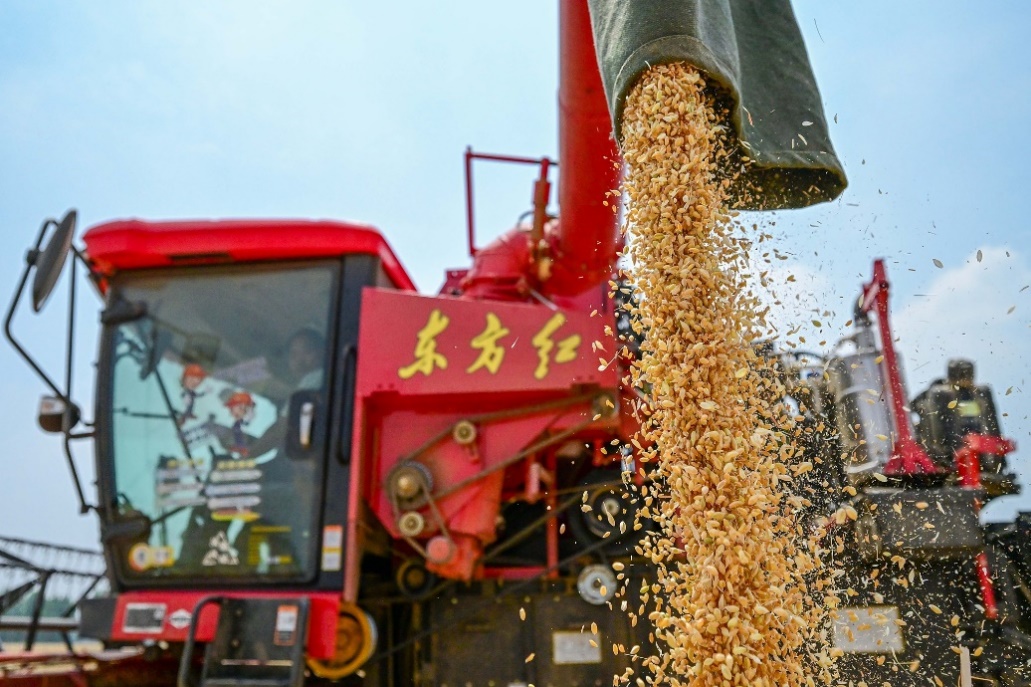近日,2025年中央一号文件《关于进一步深化农村改革 扎实推进乡村全面振兴的意见》正式发布。文件聚焦农村改革,要求严守保障国家粮食安全和不发生规模性返贫两条底线,深入实施乡村发展、乡村建设和乡村治理“三大行动”,着力健全“人、地、钱”要素保障和优化配置体制机制,扎实推进乡村振兴事业行稳致远。
浙江大学中国农村发展研究院(英文简称“CARD”,中文简称“卡特”)副研究员郑淋议和季晨教授受邀中国国际电视台(CGTN)撰文“Institutional reform stands out in China's 'No. 1 central document'”,对今年的中央一号文件进行解读,相关内容发表于2025年2月24日CGTN官网。据悉,这也是我院两位教师继去年首次在CGTN撰文之后,再次受邀解读中央一号文件。
Institutional reform stands out in China's 'No. 1 central document'
Zheng Linyi , Ji Chen

Farmers dry peppers in Bozhou, east China's Anhui Province, August 21, 2024. /CFP
Editor's note: Zheng Linyi, a special commentator on current affairs for CGTN, is an associate research fellow at the China Academy for Rural Development (CARD), of the School of Public Affairs under Zhejiang University. Ji Chen, a special commentator for CGTN, is a professor at the CARD. The article reflects the authors' opinions and not necessarily the views of CGTN.
On February 23, the Central Committee of the Communist Party of China (CPC) and the State Council jointly issued the 22nd "No. 1 Central Document" of China, entitled "Opinions on Further Deepening Rural Reforms to Solidly Promote the Comprehensive Revitalization of Rural Areas." In this document, "reform" stands out as the most prominent feature, being mentioned 14 times. The term "mechanism" related to reform is mentioned 27 times, "system" is mentioned three times, "policy" is mentioned 11 times and "institution" is mentioned 14 times. This demonstrates the determination of the Party and the state to accelerate the comprehensive revitalization of rural areas and also points to the main directions of agricultural and rural modernization.
China's reform and opening-up is a crucial institutional tool that has enabled the Party and the people to make achievements in keeping pace with the times. Since the implementation of reform and opening-up, especially since the 18th National Congress of the CPC in 2012, the Central Committee of the CPC has attached great significance to the work related to agriculture, rural areas and rural residents, that are also known as the "three rural issues." It has led and promoted the modernization of agriculture and rural areas in the new era, and historic achievements have been made in the fields of agriculture and rural areas.
According to data from the National Bureau of Statistics of China, between 2012 and 2024, the total grain output rose from 1,179.1 billion jin (589.55 billion kilograms) to 1,413 billion jin, remaining stable above 1,300 billion jin for 10 consecutive years. The per capita disposable income of rural residents increased from 7,917 Chinese yuan ($1091.85) to 23,119 yuan.
However, confronted with the complex international and domestic situations, China's development is facing a growing number of uncertain and unpredictable factors. The more we tackle risks and challenges, the more imperative it is to solidify the foundation of the work related to agriculture, rural areas and rural people.
With our sights firmly set on the objectives of comprehensively revitalizing rural areas and building a strong agricultural nation, we must persist in advancing rural reforms. We should spare no effort to boost agricultural efficiency, empower rural areas and increase farmers' earnings, thus providing fundamental support for the promotion of Chinese modernization.
Firstly, it is essential to firmly safeguard the two bottom lines, which are ensuring national food security and preventing large-scale relapse into poverty. This is crucial for bolstering the fundamental foundation of the work concerning agriculture, rural areas and farmers, and for ensuring that all reform undertakings progress steadily and favorably.
On the one hand, we should refine the policy system supporting grain production, optimize the coordination mechanism between agricultural product trade and production, establish a diversified food supply system and improve the long-term mechanism for saving grains and other food items. In doing so, we can continuously enhance our capacity to ensure and stabilize the supply of grains and other crucial agricultural products.

Farmers load freshly harvested wheat into trucks in Ruyang County, Luoyang, central China's Henan Province, May 21, 2024. /CFP
On the other hand, we need to comprehensively establish a mechanism for preventing rural areas from reverting to poverty and a stratified and categorized assistance system for low-income populations and less-developed regions. Additionally, we should improve the long-term management mechanism for the assets formed through state investment in poverty alleviation efforts. By doing this, we can sustainably consolidate and expand the achievements of poverty alleviation and effectively integrate them with rural revitalization.
Secondly, it is imperative to thoroughly implement the three major actions of rural development, rural construction and rural governance, so as to promote the comprehensive upgrading of agriculture, the all-round progress of rural areas and the holistic development of farmers, and continuously propel the modernization of agriculture and rural areas to new levels.
In particular, we should focus on enriching the people through developing rural industries. By improving the mechanism for integrating farmers into agricultural development, we can diversify the income channels for farmers and continuously create more opportunities for them to pursue development and prosperity in their local areas or nearby.
Furthermore, we must pay close attention to people's livelihood undertakings. We should comprehensively plan the urban-rural layout within the county, improve rural infrastructure and public services and strengthen the governance of the rural ecological environment. This will enable rural areas to meet the conditions for modern production and living.
Apart from that, we need to enhance grass-roots innovation. Strengthening the construction of grass-roots Party organizations and the cultivation of a civilized rural culture, we should continue to transform social traditions and customs and to lighten the burden on the grass-roots level. Moreover, it's necessary to deeply promote the transformation of rural customs and maintain rural stability. By making every effort to enhance the level of sound governance in rural areas, we can ensure that rural society remains stable, prosperous, dynamic, harmonious and orderly.
Last but not least, it is essential to implement a well-coordinated strategy integrating "people, land and capital." We should improve the institutional mechanisms for ensuring the supply of essential factors and optimizing their allocation in order to provide strong support for further deepening rural reforms and steadily propel the cause of rural revitalization to achieve sustainable and stable development.
We should synergistically promote the professionalization of farmers and their integration into urban areas. Regarding the revitalization and utilization of rural land resources, we should consolidate and improve the basic rural management system, stabilize and improve the rural land contract relationship. Moreover, to address the rural capital outflow and insufficient capital issues, we should prioritize and ensure adequate investment from the public budget in the agricultural and rural sectors.
Practice knows no bounds as does reform. Rural reform in China is always ongoing. Facing Chinese modernization, we need to further deepen rural reforms, steadily promote the all-round revitalization of rural areas and strive to make substantial progress towards the goal of building a strong agricultural nation.


